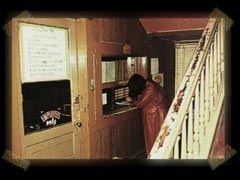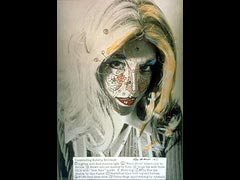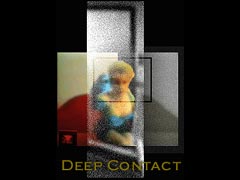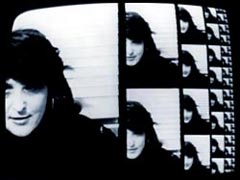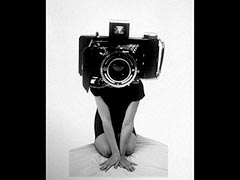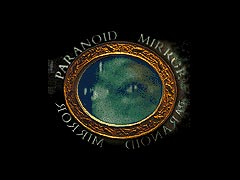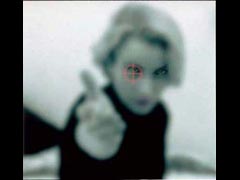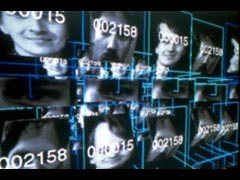| http://www.lynnhershman.com |
 |
|||
| |
|
Prior to this decade, there has been no media available to dissolve the boundaries between art and life as effectively and as instantly as cyberspace which can not only erase social boundaries but irrevocably alter the idea of what identity itself is. A precondition to electronic access is the to being one or even several other people. There are many reasons for this. In his book The Virtual Community, Homesteading On The Electronic Frontier, Howard Rheingold notes that people seem to need to use depersonalized modes of communication in order to get personal with each other. It is a way to connect. Plugging into cyberspace requires the creation of a personal mask. It becomes a signature, athumb printt, a shadow, and a means of recognition. Primitive tribes also use coverings. Masks camouflage the body and in doing so liberate and give voice to virtual selves. As personal truth is released, the fragile and tenuous face of vulnerability is protected. One of the more diabolical elements of entering CMC (Computer Mediated Communication) or Virtual Reality is that people can only recognize each other when they are electronically disguised. Truth is precisely based on the inauthentic! Masks and self-disclosures are part of the grammar of cyberspace. It is the syntax of the culture of computer-mediated identity which, by the way, can include simultaneous multiple identities, or identities that abridge and dislocate gender and age. Identity is the first thing you create when you log on to a computer service. By defining yourself in some way, whether it is through your name, a personal profile, an icon or mask, you also define your audience, space and territory. In the architecture of networks, geography shifts as readily as time. Communities are defined by software and hardware access. Anatomy can be readily reconstituted. Masking through computer mediated communication is read differently than in real life. You can be anything you can imagine, instantly, with very few props or prompts. Self-created alternate identities become guides with which to navigate deeper access of Internetting. You do not need a body to do this. Not only do you not need a body, but entering cyber space encourages a disembodied body language. Posing and emoting are some of the terms for phantom gestures that can be read through words, or seen in special video programs through simple movements such as waves. Codes of gestures can be read by attachments on the computer that articulates hidden meanings of voiceless and mute speech. Actions are constantly under surveillance, tracked, traced, digitized and stored. Icons as masks are of particular importance because the disguises used today may determine an archetype of the present that will eventually reflect the ephemeral nature of a society geared towards image manipulation and self recreation. In the search for contact, Computer Mediated Communications solicit two-way dialogues. These require mutual narrative s(t)imulations. While often subliminally fulfilling and inherently filled with amorous potential there have been some recent incidents that have caused disturbances. Let me describe three famous case studies in the cyber world annals. Case # 1: The Strange Case of the Electronic Lover A classic example is related in "The Strange Case of The Electronic Lover" by Linsy Van Gelder, which was published in Ms magazine in October 1985. Van Gelder met "Joan" on Compuserve, and began to chat. It was learned that Joan was a neuropsychologist in her late twenties, living in New York who had been disfigured--crippled in fact--and left mute by an automobile accident at the hands of a drunken driver. Joan's mentor, so the story went, had given her a computer, modem and subscription to Compuserve where Joan blossomed into a celebrity. Her wit and warmth extended to many people. Eventually, however, Joan was unmasked...defrocked (so to speak) and it was discovered that she was not disabled, disfigured, mute or female. Joan was in real life a New York psychiatrist, Alex, who had become obsessed with his own experiments in being treated as a female. The shock in the electronic world had a higher voltage than anywhere else. The assault of this discovery was coupled by the fact that Joan had achieved an intimacy with many people who trusted her. Joan's very skeleton was based on pure deception. Van Gelder is quoted as saying that "through this experience, those who knew Joan lost their innocence."2 In the real world, it could be thought of as a kind of rape--a deep penetration by a masked stranger. Questions of ethics and behavior ensued so as to avoid further incidents of netsleazing and other repulsive forms of bad etiquette. Alex had cleverly called upon the icons and codes of a society that has learned to fantasize media-produced females in a particular way. He chose to be a woman, a gender marginalized in technology. Most people logging on are men. When Joan logged in it was 1986, and women chatting was unusual. It still is so unusual, in fact, that even today whenever someone logs on as a woman there is a barrage of questions in order to determine whether it really is a woman, or someone just trying on a new sex for size. It is a kind of harassment that people logging on as men or animals do not experience. Furthermore, Alex chose to make Joan the epitome of vulnerability. Perhaps whetting desires even more by making her paralyzed and mute. The fictional presumption was that in real life she had lost her body, yet she could still be seductive. In fact she could even lure her responders, like the Sirens calling Odysseus, into lustful responses to her non-body. Case # 2: Vito In February 1993, a housewife signed up for a computer service to access information and make friends. She found she was able to form onlinee relationships that quickly became intense. She could form close connections that were hard to make in the busy world of real life. However, very quickly "she found herself the target of an invisible high-tech predator who threatened to become an all-too-real menace to her children".3. She began to have vile, unsolicited messages from someone known as Vito. She had no idea if Vito was a man or woman, a friend of her children and family or a psychotic maniac. Vito was able to tap into all of her messages, get a bit by bit profile of her and post wider messages to all Internetters. The targeted woman complained that it was like "rape". Again without a body. She sought out a computer crimes detective. Vito became well known, even infamous. Many people claimed to be him, just as many people claim to have committed the crimes of Ted Bundy. When a suspect was finally arrested, the District Attorney was forced to release him because of "insufficient evidence". Which brings up the question of how to bring law and order to the information superhighway, a place where villains are invisible and users become unwitting victims in crimes of the non-body. The Electronic Frontier is attempting to do this and have been enormously effective since their creation. A self-sponsored group, they are like what Ralph Nader was to ecology; a hacker posse who round up, capture and hold virtual vigilantes accountable. These not only include hackers. They have also questioned the computer and privacy invasions launched by the United States Government. New users are forming the largest immigration in history. What happens to this population's non-body is of critical importance. Case # 3: Terra About 1990, Tom Ray created a virtual computer that had evolved creatures. As Kevin Kelly notes, in his book Out of Control, "Beginning with a single creature, programmed by hand, this 80 byte creature began to reproduce by finding empty RAM blocks 80 bytes big and then copying itself. Within minutes, the RAM was saturated with replicas. By allowing his program to occasionally scramble digital bits during copying, some had priority. This introduced the idea of variation and death and natural selection, and an ecology of new creatures with computer life cycles emerged. The bodies of these creatures consisted of program memory and space. A parasite, this creature could borrow what it needed in the RAM to survive." [4] Furthermore, to everyone's astonishment, these creatures very quickly created their version of sex--even without programming! Sometimes in "Terra" (which is what Ray called this system) a parasite would be in the middle of asexual reproduction (genetic recombination), but if the host was killed midway, the parasite would assimilate not only that creature's space but also part of the dead creature's interrupted reproduction function. The resultant junior mutant was a wild, new recombination created without deliberate mutation; A kind of inbred vampiristic progeny, an unrestrained strain, Body-less sex In an Anti-Body ecosystem for co evolution. Cultured in the Digital Pool! What could be more appealing? Getting back to the rational non-reality we have learned to love and trust or, in other words, the real world, it becomes all too clear that much that is considered ground breaking is not really new. And that each perspective we have today derives from a point originally placed many years earlier. Consider, for example, the rules for one-point perspective, written by Alberti five hundred years ago. His mathematical metaphor was first applied to painting and drawing and promulgated an age of exquisite illusionism. Artists who used his theories could paint windows onto imagined vistas with such precision that viewers were impressively deceived. Was this ethical? What implications did it have? Did Donatello or Vermeer question the vistas of voyeurism their windows would invite? In an effort to eschew illusion, Marcel Duchamp investigated the essentials of art production, including selfhood and the uncontrolled idiosyncratic inner impulses. The sine qua non of art, according to Marcel Duchamp, is not some essence or quality residing in the final work, but rather an infinitely subtle shifting of the intent of the artist. In works of Duchamp such as Rrose Selavy, the intent and body of the artist are the sine qua non of artistic practice. Rrose was a non-body through which Duchamp could escape fixed identity, becomingng an "other" in the process. Otherness refers in this case to something defined by what it is not. There is a relationship between Duchamp and his contemporary, Heisenberg. The irrationality of Heisenberg's theories of the observer affecting what is observed in Quantum Mechanics found at the interior of extreme physics metaphorically reflects Duchamp's "experiments" regarding randomness and chance. [5] They were traveling to the same place, but on different roads. Both were looking for the path not taken. Don't byte off more than you can eschew This pre(r)amble as been leading up to the development of my own body of non-body and anti-body work produced in the past three decades. I divide my work in two categories, B.C. and A.D., or Before Computers and After Digital. I will begin with the first. In the 1960's, I lived quite literally in B.C. or, Berkeley, California. Ideals of community, alternative, reprocessed media, free speech and civil rights were constantly in the air. I could hear amplified speeches of radical heroes, such as Malcom X through my open windows. In those volatile years, art and life fused, political performances took place in the streets. I didn't realize until a decade later that the attitude of that era was to form the basis of my psychological armature, the framework for all the work that followed that time. Consistently, my most relevant ideas occur on the cusp of some disaster. In 1972, The University Art Museum in Berkeley, closed an exhibition of mine because I used audio tape and sound in a sculpture titled "Self Portrait as Another Person." The museum curators claimed that electronic media was not art and most certainly did not belong in a museum. This closure opened a second phase in my work and inspired my first radical act! Early B.C. non-body works From 1960-70, I created various wax masks that both talked to viewers through audio tapes or dissolved, extinguished by fire. A few years later, in 1972, I created my first non-body work in an actual hotel room in The Dante Hotel. The identity of the person was defined by the objects that surrounded her taste and background. In painting, it might be called negative space. Books, glasses, cosmetics and clothing were selected to reflect the education, personality and socioeconomic background of the provisional identities. Pink and yellow light bulbs cast shadows and audiotapes of breathing emitted a persistent counterpoint to the local news playing on the radio. Thus my path to non-body works and interactivity began, not with technology, but with installations and performances. Visitors entered the hotel, signed in at the desk, and received keys to the rooms. Residents of the transient hotel became "curators" and cared for the exhibition. I intended to keep the room permanently accessible, gathering dust and being naturally changed through the shifting flow of viewers. But "real life" intervened. Nine months after the opening, a man named Owen Moore came to see the room at 3 a.m. and phoned the police. They came to the hotel, confiscated the elements and took them to central headquarters where they are still waiting to be claimed. It was, I thought, an appropriate narrative closure. Yet even in its tenuous and short lived existence, The Dante Hotel became one of the first alternative space or public artworks produced in the United States. It was site-specific four years before the term was coined. The identities of the non-bodies inside were formed by what was absent. The drive to alter "found environments" that existed in real life persisted. Eventually temporary works were installed in such unlikely places as casinos of Las Vegas, store windows in New York, even walls of San Quentin Prison. In each the idea was the same; to transform what already existed through an interactive negotiation of simulated or "virtual" reality. And to define the "identity" of each context in terms of the "other" or what was not there. Inside the Dante Hotel room # 47 was "essence" of an identity. When the room closed, it seemed important to liberate the essence of the person who might have lived there, to flesh out experience through real life. This led to a ten year project titled ROBERTA BREITMORE; a private performance of a simulated persona. In an era of alternatives, she became an objectified non-bodied alternative personality. Roberta was at once artificial and real. A non-person, the gene of the anti-body, Roberta's first live action was to place an ad in a local newspaper for a roommate. People who answered the ad became participants in her adventure. As she became part of their reality, they became part of her fiction. I wanted Roberta to extend beyond appearance into a symbol that used gesture and expression to reveal the basic truth of character. She had credit cards, checking accounts and more credit than I did (still does). Roberta was an interactive vehicle with which to analyze culture. Her profile was animated through cosmetics applied to her face as if it were a canvas, and her experience reflected the values of her society. Roberta participated in trends such as EST and Weight Watchers, saw a psychiatrist, had her own language, speech patterns, handwriting, apartment, clothing, gestures and moods. Most significantly, she witnessed and documented the resonant nuances of that culture's alienation. Over time Roberta accumulated 43 letters from individuals answering her ads and she experienced 27 independent adventures. Her most difficult test was staying in character during psychiatric sessions, and her most dangerous was being asked to join a prostitution ring. Roberta's manipulated reality became a model for a private system of interactive performances. Instead of being kept on a disc or hardware, her records were stored as photographs and texts that could be viewed without predetermined sequences. This allowed viewers to become voyeurs into Roberta's history. Their interpretations shifted, depending on the perspective and order of the sequences. In her fifth year of life, Roberta's adventures became so archetypically victimized that multiples were created. Even with four different characters assuming her identity, the pattern of her interactions remained constant and negative. After zipping themselves into Roberta's clothing, each multiple began to also have Roberta-like experiences. They were, perhaps like Tom Ray's computer viruses that filled the RAM space of real life, taking with them the genetic codes of Roberta's non-embodiment. Many people assumed I was Roberta. Although I denied it at the time and insisted that she was "her own woman," with defined needs, ambitions and instincts, in retrospect, I feel we were linked. Roberta represented part of me as surely as we all have within us an underside, a dark, shadowy cadaver that we try with pathetic illusion to camouflage. Roberta's traumas became my own haunting memories. They would surface with no warning, with no relief. She was buried deep within me, a skin closer to my heart. The negativity in her life affected my own decisions. As a "cure", Roberta was exorcised. The Exorcism ritual took place in Lucretia Borgia's crypt in Ferrara, Italy. Before the ceremony, Roberta had been a sculptural life/theater performance; a sociopsychological portrait of culture seen through an individual woman who metaphorically became everywoman. The exorcism and subsequent transformation through fire, water, air and earth, incorporating the alchemical colors from white to red to gray to black, and her rebirth out of ashes, represented a symbolic invocation for change away from powerlessness. In completing the ritual, Roberta's non-body disintegrated, slowly dissolving into the smoke of her reincarnation. Roberta was not my only work with alternative non-body images. Jerry Rubin had visited the Dante Hotel, knew about Roberta and asked me to work with him on creating the visual elements of his public identity. There were similar elements in his reconstruction as were used in Roberta's deconstruction It was a kind of non-body image cannibalization. Roberta's exorcism took place in 1979. When the smoke cleared, it was 1980. That year I picked up my first video camera. Video and interactive systems became a tool for retracing the body of my personal history. It was a fortunate coincidence that as video was defining its language, I was finding my voice. In each of the 53 videotapes I have completed since Roberta's exorcism, the idea of "site" or medium becomes part of the content. Though each is quite different from the other in external appearance and content, many of the tapes are about surveillance, voyeurism and the inherent dangers of technological systems and media based reality in which identity is threatened. In "Longshot" (1989), for instance, a video editor, Dennis, obsessively pursues the image of a woman whose identity is fleeting and fragmentary. As Dennis tries to edit together Lian's reality, it becomes more fractured and fragile. Lian is a non-person, marginalized in her culture. The romance begins without her, and the seduction continues on the tape, without her corporeal presence, in Dennis's editing room. "Seeing is Believing" (1991) is about a 13-year-old girl who uses a video camera to search for her missing father and lapsed history. Eventually she finds both but through the process dissolves her "essence" into the "negatives" of the film itself. In "Desire Incorporated" (1990), actual seduction ads were aired on television. Those who responded were eventually interviewed as to why they wanted to meet a fantasy or artificial person. The answers were woven into a videotape about "desire". "Virtual Love" (1993) is about a shy woman, Valerie, who, discouraged with her own real body, implants someone else's image into the computers of identical twins, one of whom (Barry) she is infatuated with. This surrogate non-body, Marie, causes Barry to fight with his girlfriend, as well as to reach into the system to find his perfect simulated, virus free mate. "Seduction of a Cyborg" (1994) is about the infection of technology into the body, and the addition this causes. In this, the female central character eventually becomes part of the technology, seduced into cyborghood, where she both participates and witnesses the pollution of history. The effects were designed from digitized and manipulated images of computer chips. "Twists of the Cord" (1994) is about the history of the telephone, but within the story, Michelle becomes involved in a phantom or virtual relationship with RU Sirius. Both have sex with non-bodies, using the screen as a simultaneous condom and connection. "Double Cross Click Click" (1995) is about the RAMifications of cross dressing on the Internet. "The Electronic Diary" (1984-95) has many parts. This personal work talks about the relationship of the invisible body and a "talking head". Often the body will fracture or rupture in the process of coming to self understanding. Phantom Limbs, Interactivity and Disappearances For the past decade I have been creating a series of photographs known as Phantom Limbs. These each articulate references to the mutation of the female body through the seduction of media. Reproductive technological parts sprout from the image of the female, creating a cyborgian reformation as parts of the real body disappear. While video was like a reflection that did not talk back, interactive works were like a trick, two-way mirror that allowed you to have a dialogue with the other side. I found this deeply subversive! I consider Lorna, the first interactive artist videodisc, my entrance into electronics. Unlike Roberta, who existed in the world, Lorna never left her one-room apartment. The objects in her room were very much like those in The Dante Hotel, except that there was a television set. As Lorna watched the news and ads, she became fearful, afraid to leave her tiny room. Viewers were invited to liberate Lorna from her web of fears by accessing a remote control unit that corresponded to numbers placed on the items in her room. Instead of being passive, viewers had the action literally in their own hands. Every object in Lorna's room contains a number and becomes a chapter in her life that opens into branching sequences. The viewer/participant accesses information about Lorna's past, future and personal conflicts via these objects. Many images on the screen are of the remote control device Lorna uses to change television channels. Because viewer/participant uses a nearly identical unit to direct the disc action, a metaphoric link or point of identification is established and surrogate decisions are made for Lorna. The telephone was Lorna's link to the outside world. Viewer/participants chose to voyeuristically overhear conversations of different contexts as they trespassed the cyberspace of her hard-pressed life. There were three endings: Lorna shoots her television set, commits suicide, or, what we Northern Californians consider the worst of all, she moves to Los Angeles. The plot has multiple variations that include being caught in repeating dream sequences or using multiple soundtracks, and can be seen backwards, forwards, at increased or decreased speeds, and from several points of view. There is no hierarchy in the ordering of decisions. And the icons were made often of cut off and dislocated body parts, such as a mouth, or an eye. Once Lorna was released, I wanted to create a work that more directly involved the body of both the viewer/participant and the computer. Seven years later, "Deep Contact" was completed and participants were required to touch and/or penetrate the screen. Viewers choreograph their own encounters in the vista of voyeurism by actually putting their hand on a touch sensitive screen. This interactive videodisc installation compares intimacy with reproductive technology, and allows viewers to have adventures that change their sex, age and personality. Participants are invited to follow their instincts as they are instructed to actually touch their guide "Marion" on any part of her body. Adventures develop depending upon which body part is touched. The leather clad protagonist invites "extensions" into the screen--the screen becomes an extension of the viewer/participant's hand similar to a prosthesis. Touching the screen encourages the sprouting of phantom limbs that become virtual connections between the viewer and the image. At certain instances viewers can see, close up, what they have just passed. For example, Marion runs past a bush that, examined closely, reveals a spider weaving a web. In some instances words are flashed on the screen for just three frames, forcing the viewer to go back and frame by frame see what has been written. At other points, the Zen Master speaks his lines backwards, forcing the viewer to play the disk in reverse to understand what he has said. A surveillance camera was programmed to switch "on" when a cameraman's shadow is seen. The viewer's image instantaneously appears on the screen, displacing and replacing the image. This suggests "transgressing the screen," being transported into "virtual reality." In 1993, "Room of One's Own," my third interactive computer based installation, allowed the viewer's eyes to be immersed into the actual space of a tiny articulated interactive electronic peep show. A stainless steel box placed at eye level with movable periscopic viewing device bridges the viewer into a voyeur in a miniature bedroom scene. Within this room are several objects, similar in fact to those both in The Dante Hotel and Lorna's room. The very act of "looking" initiates the action. The viewer/voyeur's eyes are inserted into a small video monitor, so they become a simultaneous virtual participant in the scene being seen. All the while, the protagonist (the same one in "Deep Contact" but now a bit older) chides the viewer for his persistent gaze. This work is not only about voyeurism and a feminist deconstruction of the "media gaze", but also about the explosive effects attached to media representations of female identity. Furthermore, it repositions the viewer into the victim. Real-Time Virtuality In 1888, Etienne Jules Marey perfected a gun that substituted film for bullets. This camera gun has a direct relationship to not only the history of film and the eroticization of female imagery in photography and pornography, but to the horrors of our century perpetrated by weapons and translated into media by cameras. As an example, many serial killers photograph their victims, as if to capture and possess them. The associative notions of guns/camera/trigger links all media representation to lethal weapons. In America's Finest, an interactive M16 rifle addresses these issues. Action is directly instigated through the trigger itself, which, when pulled, places the viewer/participant within the gun site (this time their entire body, holding the gun). They see themselves fade under horrible examples in which the M16 was used, and if they wait, ghosts of the cycling images dissolve into the present. Again, the aggressor becomes victim and the entire body of the viewer is placed inside the site of the work. Through this complete immersion, they again, lose control of their image and become a floating non-body. "Paranoid Mirror" was inspired by the paintings of Van Eyck and in particular the "Marriage of Arnolfini." This piece uses reflection as a means of portraiture and reflected self portraiture. Though obscured and distanced, the artist's reflection watches from behind the central figures. "Paranoid Mirror" engages ideas of reflection, tracking, surveillance and voyeurism and uses the viewer as a direct interface. Sensors strategically placed on a floor cause the still image in a gold frame to activate, turn around, dissolve between sequences of reflection into both the viewer and/or other women in the videodisc sequences. In some instances, a switcher places the viewer's back into the frame, countering the direct reflection into the scrim-like layers of the images. The back of Anne Gerber's head is seen when the piece is inactive. Furthermore, Anne Gerber has experienced difficulties with sight itself, underscoring the often mistaken paranoid fear of being watched as well as the relationship of paranoia to voyeurism and surveillance. Accompanying this piece are four photographs from the filmed sequences. These images are framed so as to obscure the image. Appearances therefore, are often reflective illusions and projections of the observer. Birth of the Anti-Body At this writing, the work in which I engaged is the creation of a fictional persona, designed as an updated Roberta, who is navigating through the Internet. Surveillance, capture and tracking are the DNA of her inherently digital anatomy. They form the underpinning of her portrait. She has her own homepage on the World Wide Web and is involved with chat lines, bulletin boards and other Computer Mediated Communications. She is different from the non-body works of the 70s and 80s in that the veil of her illusion, the computer screen is sheerer than ever. I refer to her as an anti-body because of the way she was cultured. Normally antibodies produce systems of immunity from toxins in their environment. This will function as a benevolent virus that will roam the breathing form of the Internet, randomly accessing itself into uncertain home sites. Interestingly enough, terms for new technologies have ramifications in the language and times of AIDS. In reaction to an unhealthy natural environment, it rejects what exists and in order to survive, forms an other environment. This Internetted, plugged-in, anti-body is a transitory construction of time, circumstances and technology, a newly issued prescription of earlier impulses. She has chosen to negate the self hood into which she was born. Instead she shows a marked preference for the artifice of technology. Like Botticelli's "Venus" she is forward looking and seductive. But she is also optimistic and cyborgian. A pure bred Anti-body of the 90s, she moves through time, and electronic geographies of space, discreetly challenging privacy, voyeurism and surveillance in her own imitimable, mutable, and inauthentic revolutionary fashion. Since 1958, I've been obsessed with cyborgs, the merging of technological and human points of identity. This is evident in the "Phantom Limbs," where women's body parts extend from the mechanics of their capture; the "Digital Venus prints, in which the traditional nude female art historical nude is dis-embodied, erased and replaced by code, and a series of digital prints called, appropriately Cyborgs, in which identity numbers are stamped onto the faces and extensions of the transformed beings. My telerobotic dolls are also prosthetics, devices to an extended point of identity. Reliance on tracking and surveillance techniques has resulted in a culture that has a peripheral vision that extends beyond normal human physiology. In many cases, there is a merging of human and machine capabilities that create new beings, cyborgs, whose virtual reach, and in this case sight, is extended beyond physical location. Identity becomes intangible on the Internet and Tillie's face becomes a mask for the multiple expressions of the self that links each person to another. If you click on her eye (eyecons) an image of what the doll is seeing is captured and put into thvirtualal internet space. You are also able to move her entire head 180 degrees so that you can engage and exchange her peripheral vision. While you are reflected in Tillie's monitor, your image is also being captured and watched by countless unknown Internet users who are using Tillie's face as a mask to watch viewers. Voyeurism and surveillance tactics have become extensions of our "I". Cameras have become both eyecons and contact lenses. Web cameras are also used in the "Difference Engine 3" shown at ZKM. Identity Avatars are stamped with numbers that correspond in seconds to the time a viewer approaches the machine cycle through a virtual museum, and a virtual life cycle, ending up in a suspended purgatorial state after which they are permanently archived. A user can choose an avatar and through the eyes of the avatar he/she virtually travels through the museum in Karlsruhe. Web cameras are an extension of one's gaze, voyeurism in this case. By connecting two physical spaces using Web cameras and making it possible to manipulate the "view" of the other space, the boundary between the reality and virtuality of the space--and the view inside the space--disappears. As Tillie herself is both a real doll and a virtual one on the Net space, the viewer becomes a virtual persona from the other end of the connection, becoming an agent of him/herself, a cyborgian creature capable of an extended vision and reach. Once we used the words persona, robots or actors. Now the terminology for the counterfeit representation of life of digital anti bodies include avatar, cyborg or synthespians. These pixilated essences of virtual identity link into an archaeology of networks that in turn create a collective connective ethnography of information. Like computer viruses, they escape extinction through their ability to morph and to survive, exist in perpetual motion, navigating parallel conditions of time and memory. The data is itself a representation of the ubiquitous virtual posthuman essence, a new curve in our evolving cyborgian posture. If human beings are imperfect, their networks are even more so. Before long, we may be forced to confront the Faustian reflections of power that have been absorbed into our real world myth. Perhaps what we need is an ideology that embraces our otransiencence and obsolescence. For this, we need to rely on the deepest resources of human creativity to accept temporality and reformat our dreams so that they incorporate an evolution where life becomes an unfolding nexus of interlinked transformative experiences. If humans have become the interface to the larger communicative body, can soulful automatons be far behind? NOTE: "The Dante Hotel" was created with Eleanor Coppola. "Deep Contact" was created in collaboration with Sara Roberts and Jim Crutchfield. "Room of One's Own" was created in collaboration with Sara Roberts and Palle Henchel. "America's Finest" was created in collaboration with Paul Tompkins and Mat Heckert
1. Rheingold, Howard. Virtual Communities, Homesteading On The Electronic
Frontier. Harper Perennial, New York 1994, page 165. |
